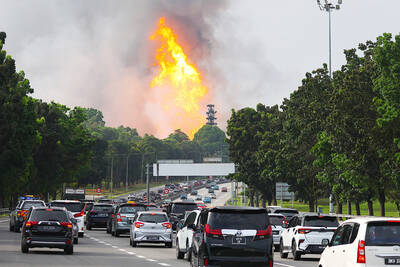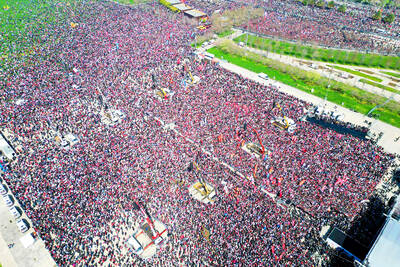New research on the conflict in Sudan’s western Darfur region shows that more than 80 percent of the 300,000 deaths since fighting began in 2003 were the result of disease, not violence.
The findings, published on Friday in the medical journal The Lancet, suggest many among the millions of people uprooted by the conflict could remain at great risk of succumbing to the malnutrition, diarrhea and waterborne diseases that have ravaged their squalid refugee camps even as fighting has ebbed.
Fighting between rebels and Sudanese government forces began in Darfur in 2003, driving 2.7 million people from their homes and creating an enormous humanitarian crisis in the vast desert region.
Sudan’s government has said the casualty figures are exaggerated.
The violence has largely subsided, but banditry and kidnappings of foreign aid workers continue to plague efforts to stabilize the region.
Researchers at the Center for Research on the Epidemiology of Disasters at the Catholic University of Louvain in Brussels, Belgium, put together the study.
They reviewed 107 mortality surveys from 2003 to 2008 and chose 63 that met all of the data requirements for their combined statistical analysis.
The study found the number of deaths from violence peaked in early 2004, a year after the fighting began with a rebellion by ethnic African tribes accusing the Arab-dominated government of neglect.
At the height of the conflict, government-allied militias known as the janjaweed burned down entire villages, government planes dropped bombs on populated areas and reports of rape by the gunmen abounded.
During that period, Darfur was called the world’s worst humanitarian crisis. Since 2005, most of Darfur’s deaths have been the result of disease, and displaced people have been the most susceptible, the review found.
Last March, Sudan’s government expelled 13 of the most important international aid agencies working in Darfur in response to an international court’s arrest warrant for Sudanese President Omar al-Bashir on charges of war crimes and crimes against humanity in Darfur.
“The full effect of the expulsion of non-governmental organizations from Darfur is still not known, but the increased mortality rate during a period of reduced humanitarian deployment in 2006-07 suggests that we should fear the worst,” the study’s authors wrote.
The review found that during that period, from July 2006 to September 2007, there was an increase in the number of people dying from disease. As a possible explanation, the report said that around the same time, there was a 40 percent increase in the number of displaced people, an 18 percent drop in humanitarian aid personnel and a decline in funding for their work. The study’s figures do not take into account those refugees who fled across Sudan’s border to camps in Chad.
The review was funded by the US State Department and the UK’s Department for International Development.
The reporting of Darfur casualty figures by aid groups and international agencies has generated debate in the past, with Sudan’s government accusing its critics of exaggerating the overall numbers of dead and the extent of atrocities.
Most recently, Rodolphe Adada, the former UN peacekeeping chief in Darfur pointed in September to the sharp decline in deaths from fighting in the first half of last year and said the world should no longer consider the conflict a war.
Activists and some Darfur residents disagreed, expressing concern that Adada’s comments would sap the momentum of an international aid effort that remains crucial.

A fire caused by a burst gas pipe yesterday spread to several homes and sent a fireball soaring into the sky outside Malaysia’s largest city, injuring more than 100 people. The towering inferno near a gas station in Putra Heights outside Kuala Lumpur was visible for kilometers and lasted for several hours. It happened during a public holiday as Muslims, who are the majority in Malaysia, celebrate the second day of Eid al-Fitr. National oil company Petronas said the fire started at one of its gas pipelines at 8:10am and the affected pipeline was later isolated. Disaster management officials said shutting the

UNREST: The authorities in Turkey arrested 13 Turkish journalists in five days, deported a BBC correspondent and on Thursday arrested a reporter from Sweden Waving flags and chanting slogans, many hundreds of thousands of anti-government demonstrators on Saturday rallied in Istanbul, Turkey, in defence of democracy after the arrest of Istanbul Mayor Ekrem Imamoglu which sparked Turkey’s worst street unrest in more than a decade. Under a cloudless blue sky, vast crowds gathered in Maltepe on the Asian side of Turkey’s biggest city on the eve of the Eid al-Fitr celebration which started yesterday, marking the end of Ramadan. Ozgur Ozel, chairman of the main opposition Republican People’s Party (CHP), which organized the rally, said there were 2.2 million people in the crowd, but

The US government has banned US government personnel in China, as well as family members and contractors with security clearances, from any romantic or sexual relationships with Chinese citizens, The Associated Press (AP) has learned. Four people with direct knowledge of the matter told the AP about the policy, which was put into effect by departing US ambassador Nicholas Burns in January shortly before he left China. The people would speak only on condition of anonymity to discuss details of a confidential directive. Although some US agencies already had strict rules on such relationships, a blanket “nonfraternization” policy, as it is known, has

OPTIONS: Asked if one potential avenue to a third term was having J.D. Vance run for the top job and then pass the baton to him, Trump said: ‘That’s one,’ among others US President Donald Trump on Sunday that “I’m not joking” about trying to serve a third term, the clearest indication he is considering ways to breach a constitutional barrier against continuing to lead the country after his second term ends at the beginning of 2029. “There are methods which you could do it,” Trump said in a telephone interview with NBC News from Mar-a-Lago, his private club. He elaborated later to reporters on Air Force One from Florida to Washington that “I have had more people ask me to have a third term, which in a way is a fourth term